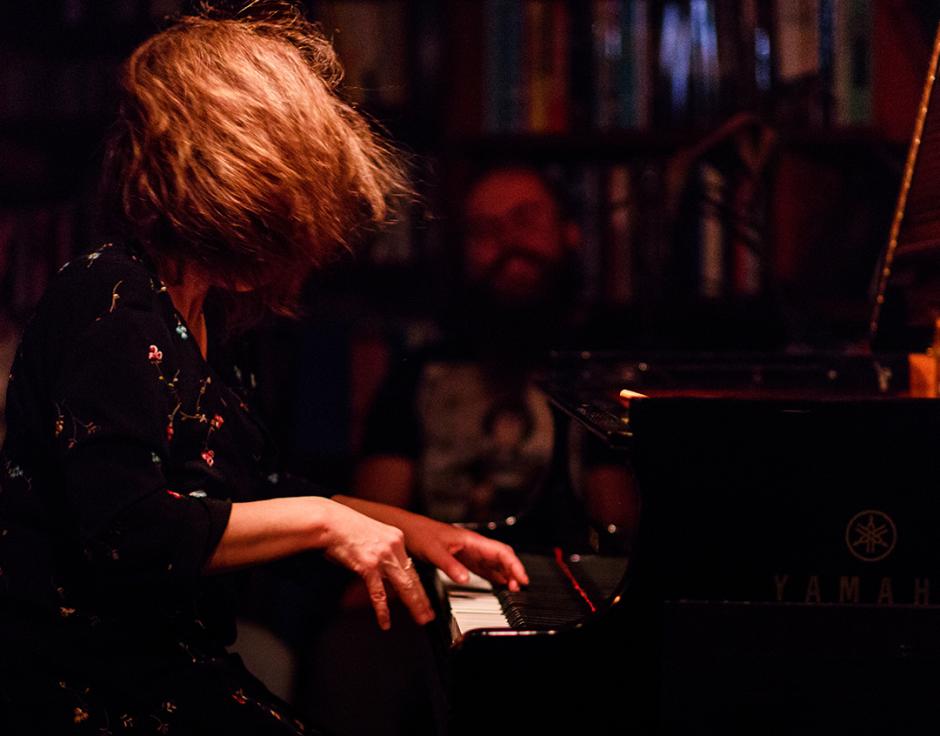“One of Europe’s finest improvisors”: Sophie Agnel reviewed
October 2025

Sophie Agnel. Photo by Sean Kelly
The creative scope of French pianist Sophie Agnel is demonstrated across two remarkable albums, writes Stewart Smith in The Wire 501
Learning
Otoroku DL/LP
Song
Relative Pitch CD/DL
In the hands of Sophie Agnel, the piano is a percussion orchestra, a string instrument, a tone generator. Of all the improvising pianists to have incorporated post-Cageian extensions and preparations into their language, few have taken it as far as Agnel. She’s a master of playing inside the piano, deploying various tools and techniques to sound the strings and frame, but what's remarkable is how fluidly she’s integrated this with her keyboard work. The whole piano is her playground, with no boundary between the frame and keys.
Sam Williams’s recent short film No End captures the French musician up close. Manipulating the sustain pedal, she has rubber balls dancing across the strings to create a dissonant music box jangle. A cut and she’s placing plastic cups inside the piano, adding a fricative quality to the deep harmonic drone she produces by slowly sweeping a metal file across the strings. Agnel’s rigour, sensitivity and invention are second to none. As she remarks in a voiceover, “If I don’t find new things, if I don’t take risks, for me there is no music.”
That risk-taking spirit has established Agnel as one of Europe’s finest, if undersung, improvisors. She contributed to Daniel Blumberg’s The Brutalist soundtrack, and counts Daunik Lazro, John Butcher, Joke Lanz, Phil Minton, Jérôme Noetinger, John Edwards and Steve Noble among her collaborators. Until this year, Agnel had two solo piano albums to her name: Solo (2000) and Capsizing Moments (2009). Now we have Learning, drawn from recent live performances at London’s Cafe Oto, and Song, from sessions at Les Instants Chavirés in the Parisian suburb of Montreuil. This month's release of Learning comes with the news that Agnel is currently recovering from a brain tumour, which will mean starting again with the piano: her quest for new things continues.
While Song is organised around a set of songs or poems, the two sides of Learning capture the longer arc of concerts from 2023-24. The first side begins with Agnel patiently working over a two chord motif, the accumulating overtones adding impressionistic colour. Into that space, she introduces inside piano effects: the percussive thump of her palm coming down on the prepared strings, the alveolar gnawing of scraped strings, the knock and thrum of a marble rolling around the frame, the lonesome twang of a plucked string. Each new sound brings a sense of strangeness and surprise, yet there’s an underlying compositional logic at work that makes it all the more compelling.
Towards the end of the A side, she brings organ-like chords into play, likely the result of electromagnets and small metal bowls on the strings. A high keening harmonic emerges as the focal point around which she brings the piece to a conclusion. Stark single notes set up a 16th note pattern on the right hand, which Agnel relentlessly works over so that the percussive qualities of her fingers drumming on the keys become part of the texture.
The B side is darker, with Agnel playing ominous figures in the bass register. Pale shafts of light come through with the vocalic timbre of bowed or rubbed strings, underlined by a mechanical chittering and grinding from inside the frame. Agnel maintains this uneasy atmosphere through several passages, before some major chords break through the clouds around the 13 minute mark. There’s no simple resolution, however. Insistent tuplets settle into a jabbing eighth note pattern which Agnel plays rubato, evoking a broken alarm clock. Crunchy percussive sounds collapse into bowed creaks and scrapes around a single plaintive note which slowly fades into the ether. A stunning performance that takes you places.
Each of the seven pieces on Song are distinct while forming a whole. The clamour of agitated frame knocks and metal percussion on “Song 1” seems to awaken the ghosts of old Parisian music halls, with a soprano voice emerging from a fog of white noise. Agnel’s response is to bury the apparition in a tremolando figure which builds in density and volume over several minutes. Yet those strange energies persist, manifesting in overtones, mechanical buzzes and uncanny timbral effects.
The shorter pieces focus on a particular idea. On “Song 3” Agnel makes the piano sound like a bass ngoni, her preparations giving the hammered strings a gutsy judder and twang. The harder she strikes the keys, the more ragged it gets, with the bolt rattling against the frame. With its faint shimmer of delicately brushed strings “Song 5” is barely there, while “Song 2” is a beautifully impressionistic sketch. By contrast, “Song 4” unfolds across nearly 12 minutes, with Agnel working around a series of strident rhythmic motifs that gradually dissolve into billowing clouds of sustain pedal reverberation. The prerecorded operatic voice returns to haunt “Song 7”, but this time Agnel joins in, mirroring then elaborating on the theme while various objects rattle around the frame. A coda of spare chords provides a final commentary on the ‘song’, Agnel paring it all back to the simplest of elements. The master pianist is also a great storyteller.
This review appears in The Wire 501 along with many other reviews of new and recent records, books, films, festivals and more. To read them all, pick up a copy of the magazine in our online shop. Wire subscribers can also read the issue in our online magazine library.
Leave a comment